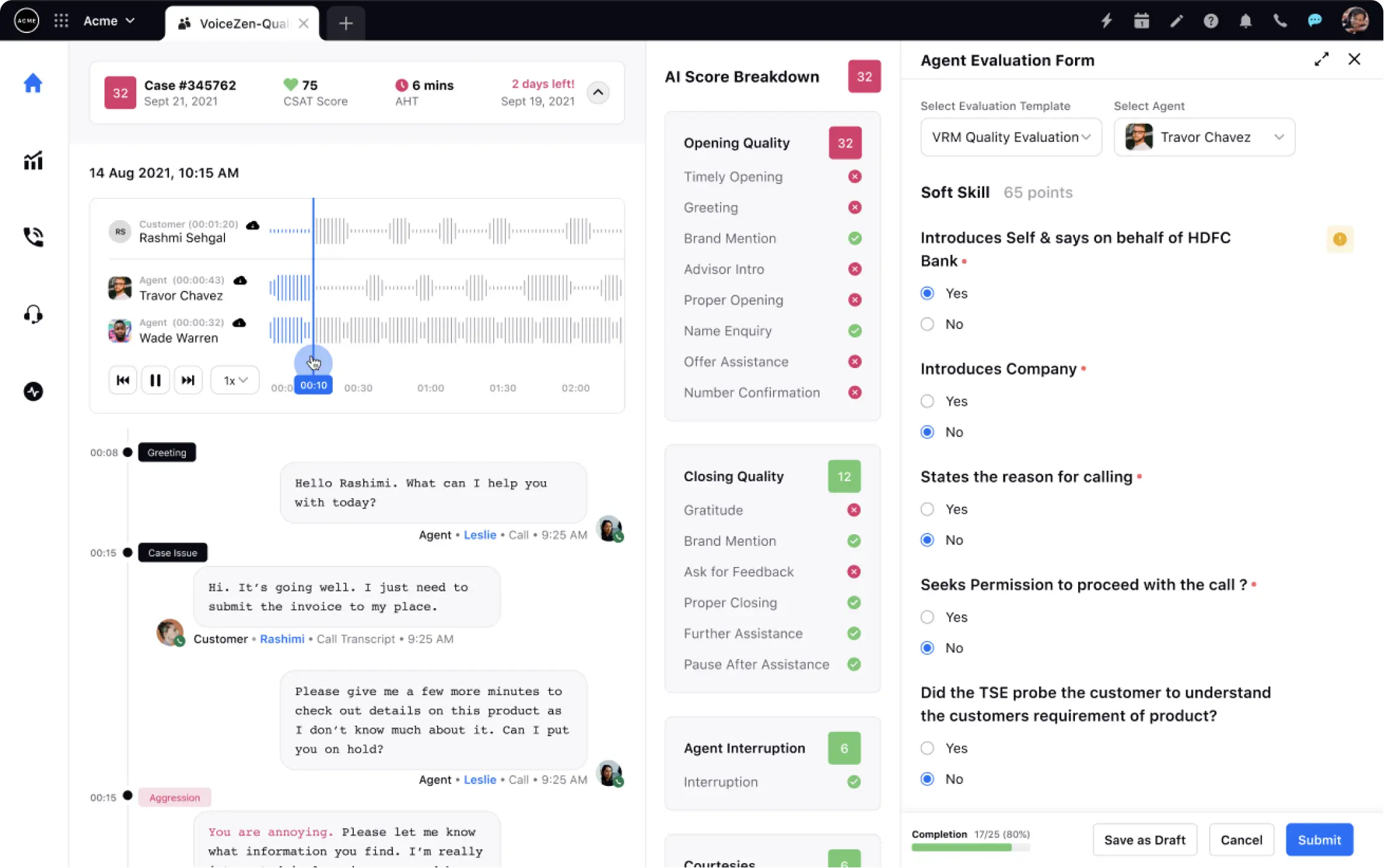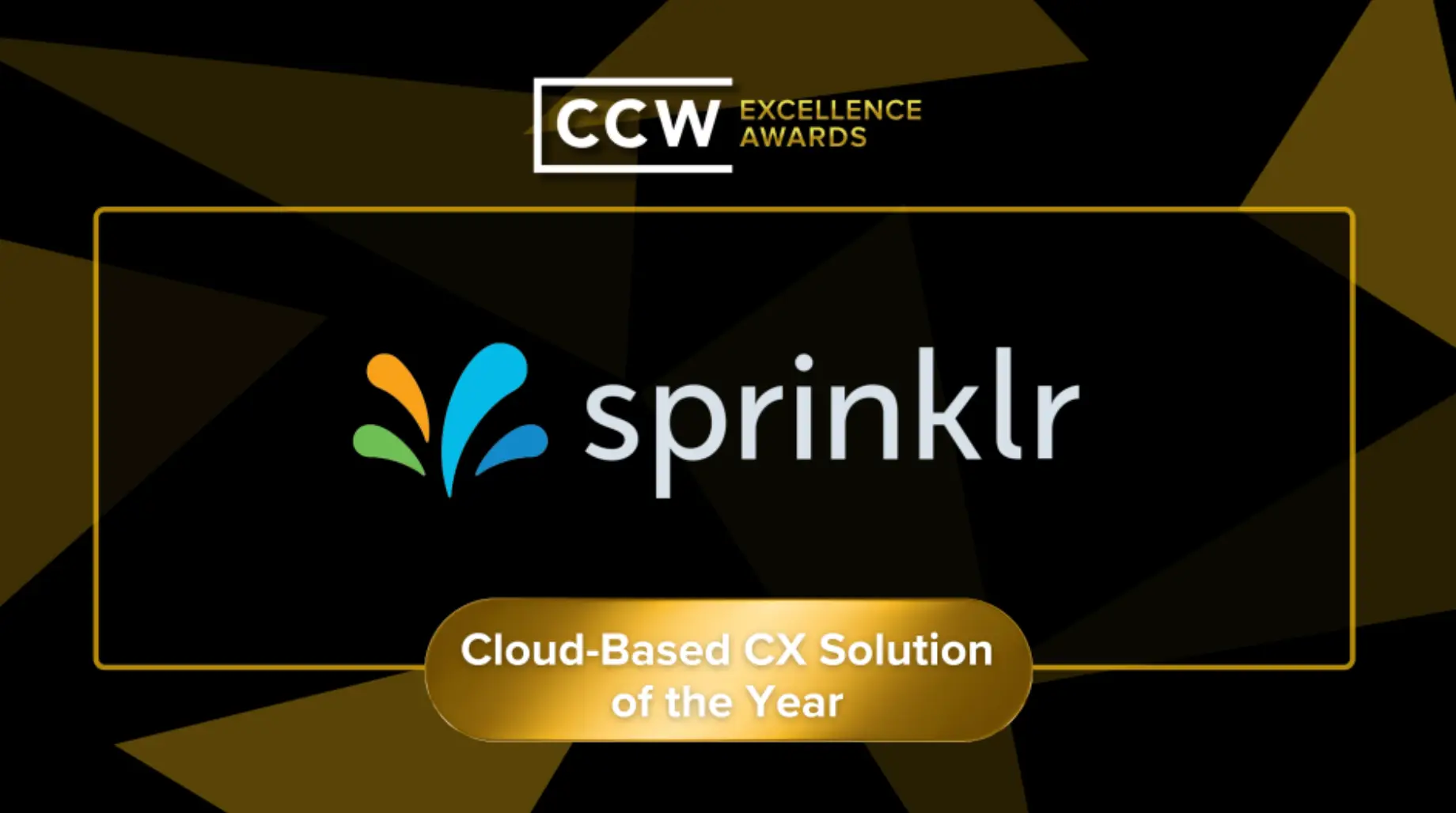The next generation of CCaaS is here
Digital-first customer service, enterprise-scale voice support. Redefine customer service with an AI-powered platform that unifies voice, digital and social channels. Power channel-less interactions and seamless resolution no matter the channel of contact.

How speech analytics improves contact center service
Your customer calls your contact center to report a billing issue.
After navigating through the IVR menu, they finally connect with an agent — only to realize that the agent has no idea what they’re talking about.
The frustration is real.
Fortunately, contact center speech analytics can help prevent such situations.
By analyzing customer conversations in real-time, speech analytics could help the agent understand that the customer issue is related to billing by identifying keywords such as "invoice," "payment" or "account balance".
Rather than searching blindly, they can now quickly access the customer’s billing history, provide relevant help and save tons of time.
In fact, speech analytics can boost productivity for 40% of contact centers by analyzing the purpose of each call.
Ready to explore how it can benefit your contact center? Let's get started!
What is speech analytics?
Speech analytics is a technology that allows contact centers to capture, store and analyze recorded call data. By using advanced algorithms and machine learning, speech analytics software can find patterns, keywords and other important data points in these conversations.
Speech analytics is like a secret weapon for contact centers, giving them powerful insights into customer behavior. With this information, they can proactively optimize operations and deliver top-notch service quality.
Benefits of speech analytics in contact centers
Ever wondered what your customers are really thinking when they call your contact center? With speech analytics, you don't have to wonder anymore. You can learn more about their needs, wants and expectations, which helps you craft more helpful responses and source more on-point resources. And that means no more guessing or relying on assumptions.
You'll be able to make data-driven decisions that improve the customer experience, optimize operations and drive revenue growth. There are many other benefits of using speech analytics in your contact center. Let’s discuss them in detail.
1. Low customer effort, high satisfaction
With speech analytics, contact centers can identify tone, buyer intent, pain points and friction from real-time calls. Armed with this knowledge, you can deliver personalized solutions that improve the customer experience.
Insights from speech analytics also reduce the need for customers to make repeat calls for the same problem. The result? Low customer effort score and high satisfaction.
2. More efficiency, reduced costs
Speech analytics isn't just good for improving customer experience; it also helps businesses work smarter, not harder.
With voice data analysis, contact centers gain understanding into customer behavior, align different departments and optimize strategies.
For example, if your contact center agents are able to identify the top trending issues by digging deep into the call data, you can get to the bottom of the issues and rectify them from the root, reducing your call volume and costs.
On top of that, speech analytics can also help you save operational costs by automating workflows and routing calls to the right channels and agents with right skills.
3. Mitigated compliance risks
Speech analytics can help contact centers avoid trouble with the law.
These tools can spot if agents are following the compliance rules at organizational and federal levels. They make sure agents are using the right scripts, disclosing the right info and keeping customer data private.
Stringent checks based on call data helps contact centers stay out of legal trouble and avoid costly fines. Plus, it builds trust with customers, knowing that their information is safe and secure.
Now that you are familiar with the benefits of speech analytics in contact centers, it’s time to formulate the powerful tool for your business. Let’s see how.
How to implement speech analytics in contact centers
Deploying speech analytics in your contact center requires meticulous planning. Check out this step-by-step guide.
Step 1. Define your strategy
Before you jump into using speech analytics in your contact center, make sure you have a solid plan in place. It's like the old saying that goes, "failing to plan is planning to fail".
Start by creating a clear strategic vision that outlines your intended use cases and goals. Are you looking to:
- Improve customer experience or reduce costs?
- Identify gaps in your team's knowledge?
- Stay ahead of trends and predict customer behavior?
- Boost positive brand perception?
Now, don't get carried away and try to do everything at once. Start small by prioritizing one or two key initiatives and get everyone on board with the plan.
Step 2. Choose the right KPIs
Look for the metrics that align with your immediate goals and can help you measure the impact of using speech analytics. For example:
- If your goal is to make callers happy, metrics such as Net Promoter Score (NPS) and Customer Satisfaction (CSAT) scores are good options
- If your aim is to reduce call volumes, metrics such as Average Handle Time (AHT) and First Call Resolution (FCR) may be more relevant
Remember, the metrics you choose should be specific, measurable and actionable.
Step 3: Pick out the right speech analytics solution
Your speech analytics software makes all the difference. The one you choose must boast a robust Natural Language Processing (NLP) engine and a suite of all the desirable features. Here are few to look out for:
- Automatic call transcription and topic extraction to help you pinpoint the problem areas and common issues
- Sentiment analysis to help you know the tone, urgency and emotional response in the caller’s voice
- Features to track agent performance like conversation quality score and time utilization trends
- AI-rich analytics to identify shifts in quality standards, SLAs and KPI peformances
Step 4: Train your team
Deploying a speech analytics solution can be overwhelming to your agents who are used to manual operations. Make it easier for them by:
- Planning it in phases: don’t overwhelm your agents with information load and take things one step at a time
- Starting with the basics: conduct simple-to-follow training sessions that give a quick overview of the tool and highlight the essentials
- Demonstrating real-life scenarios: hold customer call drills to show speech analytics process in action
Dive deeper: How does conversational speech analytics actually work though?
While following a stepwise approach to deploying speech analytics in your contact center should give you a good headstart, expect a few challenges along the way.
Overcoming challenges in implementing contact center speech analytics
Here are some common challenges contact centers face when implementing speech analytics.
1. Gaps in technical understanding
- Challenge: Picking the right speech analytics tool and getting it set up correctly can be tricky.
- Solution: Choose a solution with a user-friendly interface, customizable agent dashboard, high accuracy transcription and the most important — with great customer support. Consider building an internal team skilled with the technology to handle smooth implementation.
2. Data quality issues
- Challenge: Speech analytics relies on high-quality data and inconsistent data can lead to inaccurate insights.
- Solution: Contact centers can improve data quality by establishing data validation rules, conducting data cleansing and implementing data quality checks.
3. Data misinterpretation
- Challenge: With speech analytics generating vast amounts of data, it can be difficult for contact centers to make sense of it all.
- Solution: Automating reports and dashboards can help spot key metrics and trends. Contact centers can also collaborate with their speech analytics vendor to develop custom reports that provide deeper insights into particular business areas.
4. Privacy concerns
- Challenge: Customer calls contain sensitive and private information that is prone to data hacks.
- Solution: Contact centers can ensure privacy and security by working with vendors that offer robust data protection and security features, such as data encryption, secure data storage and role-based access control. They must protect customer data and comply with data privacy regulations such as GDPR and CCPA .
5. Integration with exisiting tech stack
- Challenge: Integrating speech analytics tools with existing contact center systems can be tough. It's especially challenging with older or legacy systems.
- Solution: Choose a vendor with pre-built integrations or open APIs that make it easy to connect to existing systems. Now that you know about how you can deploy speech analytics in your contact center, let’s look at a story of a company that did — and reaped phenomenal results.
Success story of speech analytics implementation using Sprinklr
Honda is known for its reliable cars and motorcycles, but what about their customer service?
Turns out, even the best can have their challenges.
With long wait times and frustrated customers, Honda knew they needed a solution to improve their contact center operations.
That's when they turned to Sprinklr’s Voice capabilities.
With hours of quality data training, Honda’s voice AI with robust speech analytics was ready to change the way tackled its voice-first customers.
By analyzing customer interactions in real time, Honda was able to gain valuable insights into customer needs and preferences and identify patterns and trends. Talk about being proactive! It was able to resolve potential issues before they become actual issues, resulting in a happier customer base and fewer complaints.

Final thoughts
The value of speech analytics for contact centers cannot be overstated.
But to get the most out of hours of your speech data, contact centers need to lay a solid foundation. The groundwork includes having a clear vision and strategy, building strong in-house analytics capabilities, having reliable platforms and data sources, working with external partners (when necessary) and fostering a culture of data-driven decision-making.
By doing all of this, your contact center can utilize the full potential of speech analytics to understand what your customers are saying and how they are feeling. And that’s how you can improve your services, reduce wait times and ultimately make your customers happier.


